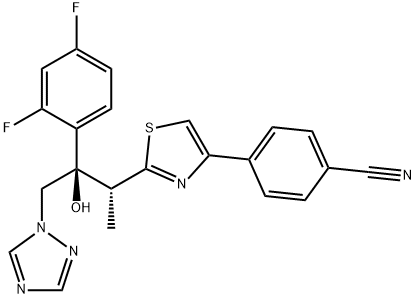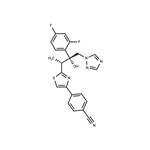Ravuconazole is an orally available triazole fungicide that potently inhibits the growth of a wide range of fungi (MICs range from 25 to 780 ng/ml). Like other azoles, ravuconazole inhibits cytochrome P450 (CYP) isoforms that are involved in ergosterol biosynthesis, interfering with the generation of the fungal and protozoan cell membranes. Ravuconazole specifically inhibits sterol 14α-demethylase (CYP51). As this enzyme is also important in the development of trypanosomes, ravuconazole is effective against T. cruzi infections in animal models of Chagas disease.
ChEBI: Ravuconazole is a member of the class of triazoles that is 1-butyl-1H-1,2,4-triazole in which the butyl group is substituted at positions 2, 2, and 3 by hydroxy, 2,4-difluorophenyl, and 4-(p-cyanophenyl)-1,3-thiazol-2-yl groups, respectively (the R,R stereoisomer). It exhibits antifungal activity by inhibition of 14alpha demethylase, an enzyme involved in sterol synthesis, resulting in lysis of the fungal cell wall and fungal cell death. (NCIO4) It has a role as an ergosterol biosynthesis inhibitor, an antifungal drug, an EC 1.14.14.154 (sterol 14alpha-demethylase) inhibitor and an antileishmanial agent. It is a member of triazoles, a member of fluorobenzenes, a tertiary alcohol, a member of 1,3-thiazoles and a nitrile.


![4-[2-[(2R,3R)-3-(2,4-difluorophenyl)-3-hydroxy-4-(1,2,4-triazol-1-yl)b utan-2-yl]-1,3-thiazol-4-yl]benzonitrile pictures](/ProductImageEN/2021-11/Small/eb9a5145-270a-4ef0-9992-9a81f7337f03.jpg)
![4-[2-[(2R,3R)-3-(2,4-difluorophenyl)-3-hydroxy-4-(1,2,4-triazol-1-yl)b utan-2-yl]-1,3-thiazol-4-yl]benzonitrile pictures](https://img.chemicalbook.com/ProductImageEN/2019-12/Small/3091d08c-401f-44fe-bf9c-7784d0ed97bc.jpg)